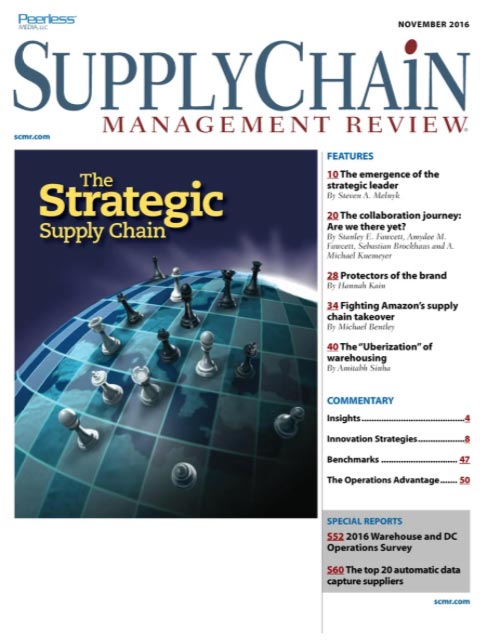Sorry, but your login has failed. Please recheck your login information and resubmit. If your subscription has expired, renew here.
November 2016
Is supply chain management strategic or tactical? Are the best supply chains collaborative? Should the goal be an integrated supply chain or an integrative supply chain? The answers are a mixed bag, according to this month’s contributors. Browse this issue archive.Need Help? Contact customer service 847-559-7581 More options
Twenty years ago, Boston Consulting Group’s Harold Sirkin warned that competition is no longer “company vs. company but supply chain vs. supply chain,” inviting a new era of supply chain collaboration. Pundits soon referred to collaborative supply chain design as the “ultimate core capability” and the “enabler of winning business models.” Based on your own experience with the day-to-day tussles that occur in the typical supply chain, you may wonder: “What on earth were they thinking?” The answer: Industry watchers had witnessed the stunning success of Honda and Toyota and viewed collaboration as inevitable.
For instance, as Honda prepared to bring the 1998 Accord to market, Honda’s internal analysis revealed two key points:
THE GOOD NEWS. Honda designers had developed an outstanding, customer-pleasing car.
THE BAD NEWS. As designed, the Accord would be too pricey. Honda needed to cut costs by 25%.
Because 80% to 85% of the typical Honda is sourced from suppliers, Honda had only one option: Ask suppliers for help. And that’s exactly what Honda did. Working with suppliers, the automaker lowered the cost of the ‘98 Accord by almost 30%. The launch was a success. Many of the technological advances developed for the 1998 Accord appeared in the next iteration of the Civic, a model that became a huge cash cow for Honda. The bottom line: Honda and its suppliers had shown that supply chains that work together win together.
 |
This complete article is available to subscribers
only. Click on Log In Now at the top of this article for full access. Or, Start your PLUS+ subscription for instant access. |
SC
MR
Sorry, but your login has failed. Please recheck your login information and resubmit. If your subscription has expired, renew here.
November 2016
Is supply chain management strategic or tactical? Are the best supply chains collaborative? Should the goal be an integrated supply chain or an integrative supply chain? The answers are a mixed bag, according to this… Browse this issue archive. Access your online digital edition. Download a PDF file of the November 2016 issue.
 |
Download Article PDF |
Twenty years ago, Boston Consulting Group's Harold Sirkin warned that competition is no longer “company vs. company but supply chain vs. supply chain,” inviting a new era of supply chain collaboration. Pundits soon referred to collaborative supply chain design as the “ultimate core capability” and the “enabler of winning business models.” Based on your own experience with the day-to-day tussles that occur in the typical supply chain, you may wonder: “What on earth were they thinking?” The answer: Industry watchers had witnessed the stunning success of Honda and Toyota and viewed collaboration as inevitable.
For instance, as Honda prepared to bring the 1998 Accord to market, Honda's internal analysis revealed two key points:
THE GOOD NEWS. Honda designers had developed an outstanding, customer-pleasing car.
THE BAD NEWS. As designed, the Accord would be too pricey. Honda needed to cut costs by 25%.
Because 80% to 85% of the typical Honda is sourced from suppliers, Honda had only one option: Ask suppliers for help. And that's exactly what Honda did. Working with suppliers, the automaker lowered the cost of the ‘98 Accord by almost 30%. The launch was a success. Many of the technological advances developed for the 1998 Accord appeared in the next iteration of the Civic, a model that became a huge cash cow for Honda. The bottom line: Honda and its suppliers had shown that supply chains that work together win together.
 |
SUBSCRIBERS: Click here to download PDF of the full article. |
SC
MR

Latest Supply Chain News
- Survey reveals strategies for addressing supply chain, logistics labor shortages
- Israel, Ukraine aid package to increase pressure on aerospace and defense supply chains
- How CPG brands can deliver on supplier diversity promises
- How S&OP provides the answer to in-demand products
- AI, virtual reality is bringing experiential learning into the modern age
- More News
Latest Podcast

 Explore
Explore
Latest Supply Chain News
- Survey reveals strategies for addressing supply chain, logistics labor shortages
- Israel, Ukraine aid package to increase pressure on aerospace and defense supply chains
- How CPG brands can deliver on supplier diversity promises
- How S&OP provides the answer to in-demand products
- AI, virtual reality is bringing experiential learning into the modern age
- Humanoid robots’ place in an intralogistics smart robot strategy
- More latest news
Latest Resources

Subscribe

Supply Chain Management Review delivers the best industry content.

Editors’ Picks





